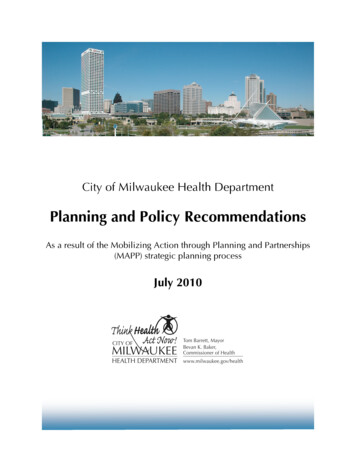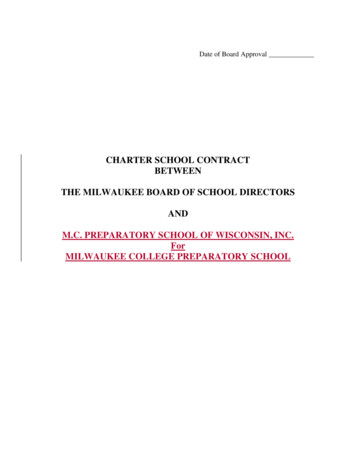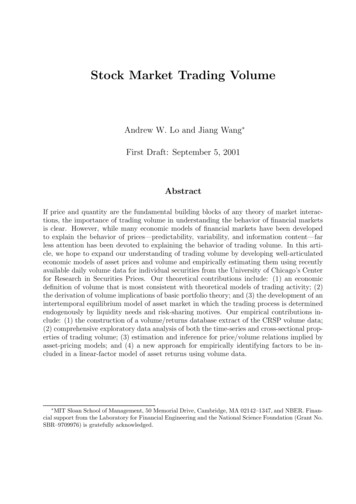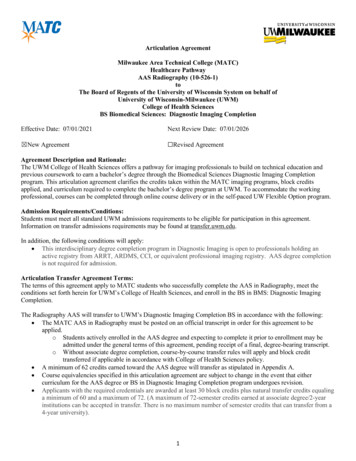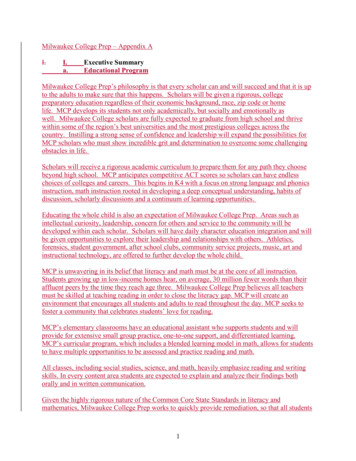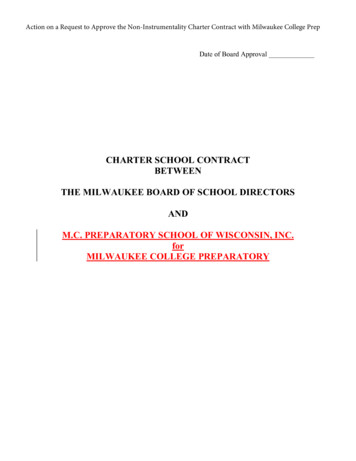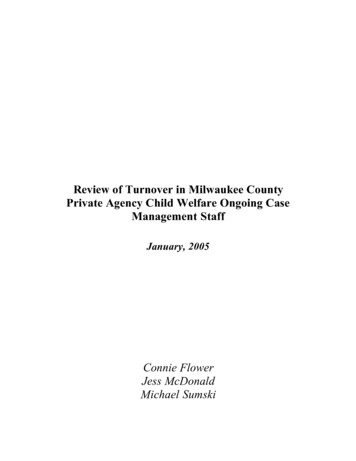
Transcription
Review of Turnover in Milwaukee CountyPrivate Agency Child Welfare Ongoing CaseManagement StaffJanuary, 2005Connie FlowerJess McDonaldMichael Sumski
EXECUTIVE SUMMARYThe review of turnover of ongoing case managers in the private agencies providing foster care andsafety services for the Bureau of Milwaukee Child Welfare(BMCW) revealed that turnover of staffremains problematic, impacts negatively the permanency outcomes of children in the system, andhas high costs to the agencies and the system. Contributingfactors to the problem include low salaryand benefits; perceived low regard for the work of ongoing staff, and of them specifically; inadequatetraining and career opportunities; and an organizational and system culture that is perceived to beunsupportive and punitive.Major strategies recommended for addressing this problem include establishing a salary and benefitpackage for ongoing staff that reflects that of the BMCW intake and assessment staff, requiring fullsocial work certification for all staff, upgrading training programs, targeting staff recruitmentactivities and the development of stronger agency based quality improvement programs.A major concern expressed is that under current plans the BMCW will place the foster care andsafety services out to bid increasing the potential for additional staff turnover. Another concern isthe potential that case transfers will be used to realign caseloads when the BMCW moves from fiveto three sites. It is recommended that the BMCW provide assurances that all current ongoing andsafety staff be guaranteed employment with the successful bidders and that no case transfers willbe used to realign site boundaries. Case transfers have the same effect on clients as do turnover - adelay in permanency.This report hopefully provides the parties and stakeholders in the Milwaukee County child welfaresystem with some alternative strategies to address this critical problem of case worker turnover.1
Review of Turnover of Milwaukee CountyPrivate Agency Child Welfare Case Management StaffHigh turnover is a national issue that impacts performance of child welfare systems and, mostimportantly, the outcomes of children and families who come in contact with those systems. AGovernment Accounting Office (GAO) study highlighted the relationship between critical childwelfare functions impacting the achievement of positive outcomes and workforce as they relate tothe Child and Family Service Review (CFSR). The report identifies that high turnover is related tolow salaries, high caseloads, limited supervision, insufficient training and concerns about personalsafety. A 2003 Annie E. Casey Foundation report estimated that annual turnover in Child Welfarewas approximately 20%. The Bureau of Milwaukee Child Welfare (BMCW) experiences turnoverrates ranging from less than 10% to 67% depending on the service area.The Governor’s Office of Wisconsin, being aware of the enormity of the issue and the potentialconsequences to children and families, requested an initial short-term inquiry to examine the issueof turnover within the BMCW. Upon early exploration it was determined that turnover rates forIntake and Assessment staff, private agency adoption staff, and foster care (licensing) staff were allunder 10%. Conversely, ongoing case management staff all employed by private agencies experienceda 34% to 67% turnover in 2003 and 2004. The BMCW views this as a major issue and was alsoidentified in a January, 2000 report by the Wisconsin Council on Children and Families, Inc.(WCCF) entitled From the Front Lines: Milwaukee’s Child Welfare Community Speaks Out. It is alsoa concern of the private agencies, the Juvenile Court of Milwaukee County, and Children’s Rights,attorneys for the plaintiffs covered by the settlement agreement. The settlement agreement and theBMCW’s operational plan identify goals, targets, strategies, and monitoring expectations concerningthe problem of ongoing case manager turnover.Given the magnitude of turnover in ongoing case management, the inquiry was primarily limited tothis area of service delivery as it directly impacts a broader scope of outcomes related to safety,permanency, and child and family well being. While Milwaukee County experiences some of thenational conditions contributing to turnover identified in the GAO workforce report, in addition toothers identified during the inquiry, it has the opportunity to address the problem with reasonablesteps.THE REVIEWThe review determined that four critical questions required exploration. Is turnover of ongoing case managers a continuing problem in Milwaukee County?Does turnover of ongoing case managers impact permanency for children?What are the costs associated with case manager turnover?What are the various factors contributing to turnover?2
Exploring each of these would be critical to determining the ultimate impact of turnover as well asinforming any considered strategies to address the issue.To illuminate this inquiry information was gleaned through various mechanisms consisting of thefollowing: Interviews with private agency chief executive officers (CEO’s) and other identifiedmanagement staff Interviews with critical state leadership of the BMCW Interviews with the BMCW’s program evaluation managers (PEM’s) Interviews with Judges and staff of the Milwaukee Juvenile Court Interviews with the University of Milwaukee training partners Meetings with the Workforce and Recruitment Workgroups Eight private agency focus groups involving 57 (26%) ongoing case managers and 28(62%) supervisors Administration and compilation of Employee Environment Surveys Agency Management Surveys encompassing staffing, caseloads, recruitment andretention data, and quality improvement activities related to turnover BMCW data and reportsThe BMCW is data and information rich, particularly in the area of program evaluation. Bureaumanagement has itself, in partnership with the private agencies, begun to address the issue ofturnover through the formulation of the Workforce Workgroup and the Recruitment Sub-Committee.While various efforts to monitor and improve turnover have begun, the fruition of these efforts hasnot yet been realized as the first critical question is explored.Critical QuestionsIs turnover of ongoing case managers a continuing problem in Milwaukee County?Evidence suggests this remains a serious problem, as suggested by the high turnover rates of 34% to67% in 2003 and 2004. One of the most important factors in achieving positive outcomes forchildren and families is consistency and continuity of case managers. This may most aptly beillustrated by a comment contained in the WCCF report, which highlighted a comment by a workerwho indicated they were a child’s tenth worker within a five-year period. At that time the child didnot want to know the worker’s name and instead elected to refer to the worker as “Number Ten.”Changes in case managers force clients to start over with new workers often resulting in a lack oftrust and delays in moving ahead with required service plan activities to achieve permanency. Inaddition, worker changes may result in delays in court hearings producing docket delays as cases arerescheduled.Between January and September 2004 clients served in Milwaukee County ongoing services, fostercare, experienced significant worker turnover. Over 40% of the family cases served by the five sites3
had more than one worker in the nine-month period (Site 1 38%, Site 2 43%, Site 3 45%, Site4 41%, and Site 48%). Of the 2899 children who remained in the Bureau’s care at the end ofSeptember 2004, 40% had more than one worker.Does turnover of ongoing case managers impact permanency for children?For those children who entered care in calendar year 2003 through September of 2004 and exited topermanency within the same time period, increases in the number of worker changes werecorrelated to lessening the chance of permanency achievement (See Graph Below). Children enteringcare during the time period who had only one worker achieved permanency in 74.5% of the cases.As the number of case managers increased the percentage of children achieving permanencysubstantially dropped, ranging from 17.5%, having two case managers to a low of 0.1% having sixand seven case managers.Fewer Changes in Caseworkers Increases the Chances of Permanency forChildrenData reported represents 679 children who entered care in calendar year 2003 through September 2004 and exitedwithin the same time period. Data reported to review staff by the Bureau of Milwaukee Child Welfare.Another measure of this problem is reflected by the high percentage of ongoing workers who havebeen on-the-job for less than twelve months (Site 3 and 5 - formally IFPI at 63 of 94 67%, Site 1and 2 - WCSN at 41 of 81 50.6%, and Site 4 - LaCausa at 15 of 44 34%).Turnover remains a real problem and it has client related implications.What are the costs associated with this high turnover of case managers?4
The cost of case manager turnover goes beyond the negative impact on clients. Those impacts delaypermanencies for children in foster care and result in unnecessary foster care expenditures. TheBureau and the partner private agencies experience direct costs as a result of turnover. The U.S.Department of Labor (DOL) estimates the cost of employee turnover to be approximately one-thirdof their annual salary. This includes cashing out benefits, additional recruitment costs, investing intraining new staff, and other related costs. Loss in productivity is not included in the DOL estimate,but may translate into agencies experiencing holdbacks or penalties should their quantitativeperformance fall below acceptable levels. A raw estimate of the cost of turnover of ongoing casemanagers who have left LaCausa, IFPI (now WCSN), and WCSN in the last eighteen months exceeds 1.4 million. Since the agencies are required to maintain caseloads at a given level, replacing exitingcase management staff must occur. This high turnover results in morale problems and potentialdeficient budgets.What are some of the factors contributing to turnover?The focus groups highlighted some of the factors they saw as contributing to worker turnover.Additionally, the results of the Employee Environment Survey, administered to all eight focusgroups prior to their participation in the group, provided additional information (See Appendix A, pg.12 – Results). The survey, developed and tested by the Gallup organization, has been used widelyto determine worker’s satisfaction. This survey has been used in Illinois for a similar purpose. Whilenot having the opportunity to talk to workers who recently left the agencies, we were able to reviewsome exit interview information provided by two of the agencies in their completed agency surveys.Twenty-six percent of ongoing case managers participated in the focus groups and 62% of thesupervisors participated. Each of the five case manager groups was agency/site specific and wascomposed of only case managers. The three groups of supervisors were agency specific andcomposed of on-going case management supervisors. Additionally, two safety supervisorsparticipated. Each focus group of on-going case managers was comprised of individuals with differenteducational backgrounds. Each group was comprised of an equal number of individuals having 6months or less experience and three years or more experience. While the supervisor groups had a mixof educational backgrounds and lengths of service, half had been employed more than three years andthe remainder less. Given the size and demographics of the groups, including a wide array of ages,it is felt that the group attendees were representative of the staff currently on-board and those whorecently exited.Some of the themes surfacing across the focus groups as contributing to turnover and dissatisfactionincluded the following: low salaries and infrequent and inadequate salary adjustments; risk ofviolence; lack of professional regard, particularly from the Juvenile Court; lack of a career ladderwithin the organization; inadequate training; and lack of support. These observations align with thoseidentified in national studies on turnover, including the GAO report on the child welfare workforce.5
Salary Concerns: The starting salary for ongoing staff is less than that offered stateBMCWstaff performing similar, yet time limited, duties such as Intake and Assessment (IA)staff. IAstaff start at 31,825 annually while ongoing staff at LaCausa start at 30,171, IFPI(now WCSN) staff started at 27,000, and WCSN staff start at 27,789. This difference becomesmore disparate with tenure since the private agencies do not offer salary adjustmentscomparable to the BMCW.Professional Regard: Ongoing staff is apparently largely not certified as social workers asis the BMCW IA staff. The requirement for use of certified staff, although part of thecontract, is routinely waived at the request of the private agencies. In two focus groups, of26 staff, only three were certified and only four others were working on their certification.Four sites comprised of 200 ongoing case managers provided data that indicates only 33(16.5%) are certified. Of the 167 non-certified staff, the information indicates that 161 (96%)have degrees (social work, psychology, sociology, criminal justice, and related human service)that qualify them for basic certification consideration as a social worker through theDepartment of Regulation and Licensing. Staff in the focus groups saw no value incertification as there would be no salary adjustment should they obtain certification.Additionally, several groups perceived an added liability should they be certified. They alsoreported that the court does not view them as professionals, instead referring to them as “laypeople.” While several focus group participants indicated that the recent meetings with theJuvenile Court Judges have improved relationships they report continued difficulty withstaff from the District Attorney’s Office. Certification, or lack of it, may contribute to thisopinion by key stakeholders.Training: Reviews of the CFSR’s suggest that states perform better when they have strongtraining programs. Some staff reported that previously offered intensive court training wasno longer available. This training was viewed by participants as very helpful. Several focusgroups identified that staff have been sent to court prior to attending court training. Casemanager groups indicated that they would like to have more in-depth training occur duringtheir respective core training. Many indicated that the basic knowledge relayed in the coretraining were concepts and topics they covered in their degree programs. The training wasperceived by many as overviews of topics and desired more directly linked content such ashands-on WiSACWIS training with real cases, accessing hard services, and completing actualpaperwork using a mock case. Instead, new workers reported they spend most of their timeasking how to execute these functions after attending training. Supervisors had various levelsof knowledge regarding their core training, with some not even aware that there was a coretraining. Supervisors echoed the concern of case managers regarding the lack of depth to thetopics and described them more as “overviews.” Supervisors reported that it is sometimesdifficult to incorporate what they learn into practice because they are so busy ensuringcompliance. Staff report that many of the on-going trainings are repetitive. They added thatthe training that they wanted or needed to attend was often so full they could not get in. Staff6
also reflected concerns about balancing their work with training, answering pages and phonemessages during breaks, lunch, and after training sessions. They also voiced concerns thatif away for an extended training other workers may not make the same efforts to cover casesand see clients on their caseloads. This was a similar concern when going on vacation.The availability of support for advanced degree education for ongoing staff appears to belimited. The GAO study reported that in Kentucky and California, two of the states theyvisited and reviewed, more then 80% of the students utilizing Title IV-E funded stipendsremained with their respective child welfare agencies after their contractual employmentobligations had expired. In a Texas study 67% of staff with a social work degree were stillworking for the agency five years later. Of those people who had a social work degree andalso held an internship in the social service agency prior to working there, the retention ratewas even higher - 87%. When queried regarding the use of social work interns in theirorganizations both supervisors and staff reported that such internships were not usuallyavailable and they believed it was due to issues regarding client confidentiality. While thismay or may not be the case, various studies support the utilization of internships within anorganization to foster future and long-term employment within a child welfare agency.Organizational Culture Issues: The private agencies involved in ongoing and safetyservices appear to be autonomous in name only. They report, for example, being instructednot to use their letterhead in certain communications, and one was told not to develop itsown mission statement. Bureau administration reported being unaware of these restrictionsexcept that letterhead must reflect the organization’s connection to the Bureau in certain legalcommuniqués. What seems apparent is a disconnect in communications. Staff, includingsupervisors, reported that there was little autonomy between their agency’s day-to-dayfunction and the span of control of the Bureau. Three case management focus groupsreported that both internal and external communication often comes in the form of memos,often without clear explanations as to why certain management decisions were made or whychanges in practice are implemented. Staff all reported that policy was available on-line butqualified this statement by adding that they have been told not to rely on it as it is out-ofdate. Communication between and among the BMCW, ongoing case managers, and theirmanagement is sometimes confused and staff report they do not feel anyone can defend themwhen things go wrong.The CEO’s believe they have almost no ability to address emerging needs, given the rigidnature of the budget/contract, while Bureau management indicates they have met with agencymanagement, when requested, to discuss alternative programming and funding strategies.Despite this divergent information, what remains is still a perception that the contract isinflexible. While financial penalties may be imposed for performance failures, few, if anyincentives reward exceptional performance. This issue is complicated even more by thehistory of agency changes during the last several years. The CEO’s feel they have no abilityto address salary issues given these constraints.7
The Bureau requires an agency to have a quality assurance plan according to the contract.The PEM’s report that this is actually required when an agency is out of compliance andthen takes the form of a corrective action plan verses a defined Quality Assurance(QA)/Quality Improvement (QI) Plan relating to their unique service arrays. What appearsto be lacking is an overall Bureau Quality Assurance and Quality Improvement Plan thatoverarches and provides continuity with similar individual private agencies plans contractedto provide the various services of adoption, foster care (licensing), safety, and ongoingservices. Staff from several agencies indicated being involved in workgroups and otheractivities which were directly involved in using quality assurance information to improveperformance, e.g. the BMCW’s workforce and recruitment workgroups, policy committees,etc. On the other hand, staff reported that if issues are raised which require the Bureau’sresponse; they usually do not obtain a response. They reported a better response when theissue was internal to the agency. However, in groups from one agency, they reported notcompleting the most recent satisfaction surveys, because they had not received feedbackfrom prior satisfaction surveys . Defining communications and a feedback loop is a keyelement contained in an agency QA/QI plan, and assists in identifying organizational identityand its relationship to other partners.Recruitment and Employment Screening: Hiring the right staff is crucial to retainingstaff. Research indicates that individuals with degrees unrelated to social work do not stayas long in their positions as those with social work or related degrees. The vast majority ofcase mangers in all the focus groups reported that neither their interview nor the jobdescription they received gave them an accurate picture of what the job entailed. Many weredrawn to working with children and families but were unaware that the majority of their timewould be spent completing paperwork. The majority of recent college graduates in the focusgroup reported the position as being “entry level” in the field of social work.Supervisors routinely reported that there is no structured interview process for casemanagers, e.g. standardized questions, and questions posed do not routinely query theinterviewee relative to the competencies necessary to perform child welfare work. Severalaccrediting bodies of child welfare agencies including the Council On Accreditation (COA),the largest accreditor of child welfare agencies, have established human resource standardsthat address the need for standardized and competency based interviews in addition to jobpreviews or the ability to speak to senior staff in similar positions.Possible Strategies: Addressing Ongoing Case Manager TurnoverThe initial strategies we would recommend are fairly basic. Hire the right staff, pay them a fairsalary and train and support them the right way. All the evidence points to this as the rightdirection. Unfortunately, the right strategies often seem out of reach or too costly. In this case theevidence strongly suggests that not addressing this issue costs more than leaving it alone, both inhuman and financial terms. The following are our suggested steps. They are viewed as a packagerather than a menu from which one might select one step, perhaps a necessary step but by itself not8
a sufficient step.1. The inadequate salary and benefits of ongoing staff are a significant factor in ongoing staff’sjob satisfaction and probably contribute to the higher than desirable worker turnover. Thesalary levels are below those offered BMCW IA staff. The salary and benefits for ongoingstaff should be adjusted to reflect a benefits package similar to that offered by the BMCW.The private agencies are responsible for the benefits packages offered their employees andas such should make appropriate adjustments as soon as is possible. Noting the perceivedand real rigidity of the ongoing services contracts, the BMCW should grant the privateagencies permission to reallocate resources in order to achieve this change. These conditionsshould be included in the required terms and conditions of the request for proposals forongoing and safety services that are soon to be let. Costs associated with implementing theseconditions should be recognized as allowable. (See Appendix-B, pg. 18 – Example SalaryApproach)2. Steps should be taken immediately to improve the professionalism of the ongoing workforce.Ongoing staff should be required to be certified social workers as is required of BMCW IAstaff. This step should be required under the terms and conditions of the proposed RFP’s.Steps have to be taken to achieve this over a reasonable, but not unlimited, period of time.The private agencies should begin immediate discussions with the various schools of socialwork to build “pipeline” programs designed to bring BSW and MSW graduates into theiremploy. The BMCW should make Title IV-E resources available to the private agencies,perhaps through the training partnership, in order to assist private agencies.3. Training programs should be intensely reviewed in order to ensure staff is prepared to takeon the difficult work of ongoing services. We would suggest the immediate development ofa training academy that supports training teams housing new employees. These newemployees would receive six months of intensive training, both theoretical and hands on.Included in this training would be intensive court training. Court training should beimmediately restored and be required of all current and new staff. The private agencies couldbuild this training effort independent of the BMCW since they would be paying salaries ofstaff in training. Ownership of the training effort by the private agencies with the trainingpartnership is still a Title IV-E reimbursable activity although at a lower rate of federalfinancial participation than if offered solely to public employees.Two additional strategies must also be considered. One, ensuring that staff hired are the most viablecandidates to be retained. The other to provide some relief to the issues related to organizationalculture, improving communication and rectifying misconceptions.1. Partial or fully standardized competency based interviews should be instituted, including theaddition of job previews. A lack of clearly defined competencies impacts the selectionprocess of new staff. While several agencies reported a waiting list of potential employees,none indicated that candidate competencies had been defined nor have questions been9
formulated which inquire into these areas. Using information obtained from exit interviewsmay also assist in formulating questions. Acknowledging the trends identified through thisprocess of information gathering may inform questions which can assist candidate selectionto help reduce preventable turnover. Providing opportunities to preview the job can help toensure that perspective hires have a better understanding upon which to make their hiringdecision. Currently, the Bureau’s workgroup on workforce and recruitment has identifiedsome of the contributors to turnover as well as formulating recruitment strategies. What mustaccompany this is a more reliable selection process that screens out potential hires accuratelyand clearly provides a pool of applicants that display the most viable competencies, thusincreasing the odds of retaining staff.2. Individual agency and Bureau Quality Assurance and Quality Improvement Plans should bedeveloped and implemented. Currently, the BMCW has multiple mechanism of programmonitoring as do the individual agencies, including multiple performance improvement plansand quality improvement activities which occur within multiple workgroups, committees,and internal and external reviews (e.g. the Partnership Counsel - planning on conductingfocus groups, the Workforce Workgroup - working on retention and recruitment, theWingspread Conferences relating to the Chapin Hall study of the BMCW, etc). Theseactivities and others all enhance the knowledge base regarding the agencies performance andits strengths and opportunities. Given the breadth of activities, formulating a concise plansupports clear communications of findings and plans for improvement. The plan can clearlydefine activities related to risk management, program evaluation and review, and consumer,employee, and stakeholder input and satisfaction. It can ensure that staffs, at all levels, havethe opportunity to participate and with that participation have a responsibility tocommunicate with their agency staff. It can effectively serve as a template within whichfeedback loops can be identified and closed, both internally within the agency, and externallybetween the agency and the Bureau, thus enhancing the overall satisfaction level of staff.Additional ConsiderationsA number of other issues contribute to the complexity of any resolution of this issue.The BMCW’s intent to place these services out to bid increases the possibility of higher turnover.One CEO reports that staff already are anxious over their future. The Courts will expect higherturnover and potential backlogs from caseload transfers, which, we understand, happened oncebefore. Private agencies cannot guarantee staff they have employment since they do not know theoutcome of the process. The BMCW might be able to address this issue but only if they guaranteeall current staff that they will be employed by any succeeding agency. This too would have to bea term of the RFP’s and contracts.10
Private agencies have an obligation to address these issues independently of the BMCW. Theongoing staff are their employees and they should be protected and developed by the private agencyleadership.The BMCW is reviewing their contracts for ways to make them more outcomes based. Althoughthere are no simple solutions, it is recommended that there be a greater focus on outcomes forchildren and families. Such a focus might lead to discussions about obstacles to reunification andadoption. The privates view the contracts as micromanagement and compliance oriented. The termsof the contracts are specific in nature and focus on important issues required by the settlementagreement. Shifting to an outcome based contract will require identifying client based outcomes. Thiswill require a conversation between all the stakeholders prior to the cementing them into specificcontract terms.A Lot of Good Work is Being Done Here So Solve This and Move On.There is so much good work going on by hundreds of very committed individuals that there shouldbe reason to celebrate the improvements. There are communications issues that every large systemexperiences. Solve these issues by sitting down with the advocates and private agencies as fullpartners in changing the child welfare system. There is richness here in Milwaukee County
Intake and Assessment staff, private agency adoption staff, and foster care (licensing) staff were all under 10%. Conversely, ongoing case management staff all employed by private agencies experienced a 34% to 67% turnover in 2003 and 2004. The BMCW views this as a major issue and was also

